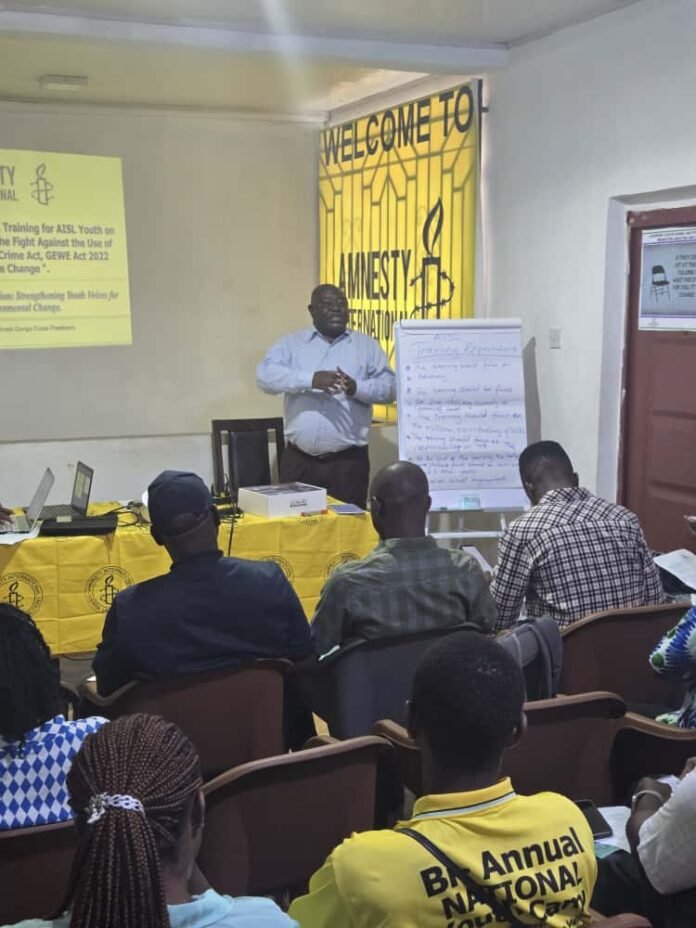
By Amin Kef (Ranger)
Statistics Sierra Leone (Stats SL) has unveiled the Employment and Remuneration Matrix (ERM) at a high-level presentation held on Tuesday, 12th November 2025, at its Head Office on King Street in Freetown. The event brought together representatives from key national institutions, including the National Revenue Authority (NRA), Wages and Compensation Commission (WCC), Bank of Sierra Leone (BSL), National Social Security and Insurance Trust (NASSIT) and the Ministry of Finance (MoF).
Delivering the welcome address, Bai Mohamed Bangura, Labour Statistician and ERM Coordinator, emphasized the matrix’s crucial role in improving understanding of Sierra Leone’s employment structure, ensuring data accuracy and strengthening national GDP compilation. He acknowledged existing challenges in data collection but reaffirmed Stats SL’s commitment to maintaining statistical integrity through rigorous and transparent methodologies.
In his keynote statement, the Statistician General and Chief Executive Officer of Statistics Sierra Leone, Andrew Bob Johnny, highlighted the importance of reliable employment and remuneration data in shaping sound labour market policies, promoting inclusive growth and addressing wage disparities. He called for greater collaboration among stakeholders to close data gaps and enhance coordination, noting that the ERM is a vital instrument for accurate GDP estimation and progress tracking on the Sustainable Development Goals (SDGs).
Chairing the session, Isata Allieu-Keikura, Head of CPI and Labour Statistics, commended partner institutions for their continued support but underscored the need for timely data submission from Ministries, Departments and Agencies (MDAs). She cautioned that delays in data sharing hinder the timely release of reports, urging all partners to sustain momentum in the ERM project.
Presenting the analytical component of the ERM, International Monetary Fund (IMF) Consultant and National Accounts Expert, Maira Caño-Guiral, explained that the matrix forms an integral part of Sierra Leone’s GDP rebasing framework. She noted that Sierra Leone now ranks among the few countries with comprehensive gender-disaggregated datasets that distinguish between the Observed Economy (OE) and Non-Observed Economy (NOE) — a milestone for data-driven economic governance.
Key Findings
- Non-Observed Economy (NOE): Accounts for 95.1% of total jobs and contributes 78.8% to GDP.
- Observed Economy (OE): Represents 4.9% of jobs and contributes 21.2% to GDP.
- Gender Distribution (NOE): Females occupy 49.7% of jobs (34% GDP contribution), while males occupy 45.4% (44.8% GDP contribution).
These figures were derived from diverse data sources, including the Integrated Household Survey, Annual Economic Survey of Enterprises and administrative records; forming a reliable foundation for economic and labour market analysis.
Representatives from partner institutions commended Stats SL for spearheading the initiative. NASSIT’s representative, Ishmael Kanu, praised the ERM’s potential to better capture informal sector participation, enhancing labour inclusion. Meanwhile, Saidu Swaray from the Bank of Sierra Leone emphasized the matrix’s significance in revealing the size and structure of the underground economy, which directly informs fiscal and monetary policy frameworks.
The Employment and Remuneration Matrix (ERM) represents a critical step toward harmonizing data on production, labour input and income, ensuring that employment statistics accurately reflect national accounts. This milestone enhances the credibility of Sierra Leone’s GDP estimates and provides policymakers with robust, evidence-based tools for inclusive economic planning and sustainable development.














